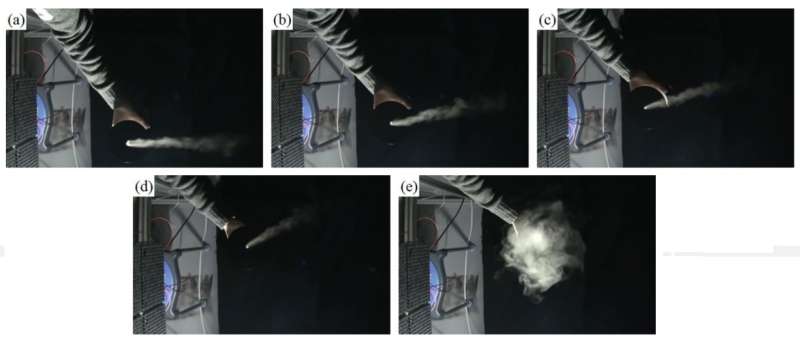August 21, 2017 feature
Scientists accelerate airflow in mid-air

When a fan blows air across a room, the airflow typically decelerates and spreads out. Now in a new study, scientists have demonstrated the opposite: an airflow created by a carefully controlled ultrasound array can maintain its narrow shape and accelerate as it moves away from the source. The researchers explain that it's as if the airflow is being pushed along by a sequence of invisible fans floating in mid-air. They expect that the accelerating air stream could have unprecedented applications, such as the ability to perform and control chemical reactions in mid-air.
The physicists, Keisuke Hasegawa et al., from The University of Tokyo, RIKEN, and Nanzan University, have published a paper on the steerable, ultrasound-driven air streams in a recent issue of Applied Physics Letters.
As the researchers explain, self-accelerating acoustic beams have been demonstrated several times before in water and in air. An important aspect of the new study is that the beams can be controlled, marking the first demonstration of an electronically steerable macroscopic self-accelerating beam in free space.
The researchers used a type of beam called a Bessel beam, which has the unusual property of not spreading out as it propagates, but rather maintaining a narrow, tightly focused shape. The scientists generated these beams using a phased array of approximately 1000 ultrasound transducers. Each transducer converts an electrical signal into an ultrasound wave, and tuning the wavefronts of these emitted waves controls the direction of the airflow. The ultrasound field also produces kinetic energy, which accelerates the air stream as it propagates forward. In experiments, the researchers demonstrated that the spot with the highest velocity can be located a foot or more away from the sound source.
One of the most interesting features of the beam is that that tilting the ultrasound array is not required to control the beam direction. Instead, the beam is electronically steerable by tuning the wavefronts, which forms a tilted beam without tilting the array. The researchers also showed that the airflow is powerful enough to be felt by the hand and to guide water vapor in a desired direction.
The scientists expect that the ability to generate an air flow with these unique properties will lead to new applications, such as performing mid-air chemical reactions, sampling a gas concentration, and in studies of ethology, such as investigating how animals respond to pheromones in the air.
"Animals react to physiological substances in the air such as pheromone," Hasegawa told Phys.org. "We expect that such substances can be conveyed to target animals and observe their reaction. Our method does not need to constrain their movement or require them to wear specific instruments. So it would offer an opportunity to observe the natural reaction of animals."
In the future, the researchers plan to further explore methods for controlling the air flow.
"Currently, we are planning to create more preferable flows for conveying airborne substances," Hasegawa said. "For example, current flows entail turbulence, which deteriorates the spatial localization of the conveyed substances. We think it possible to make the flow more similar to a laminar flow by designing the ultrasound field in a refined fashion."
More information: Keisuke Hasegawa et al. "Electronically steerable ultrasound-driven long narrow air stream." Applied Physics Letters. DOI: 10.1063/1.4985159
Journal information: Applied Physics Letters
© 2017 Phys.org



















